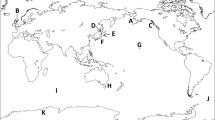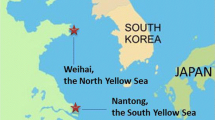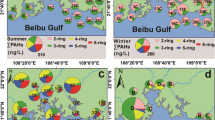Abstract
Mond protected area is a region in the northeast of the Persian Gulf with high species richness, which in recent years has undergone changes and oil pollution. Persistent organic pollutants (POPs) can damage aquatic organisms and food chains. This study was performed in May and June 2016. The purpose of the study is to specify the origin and concentration of polycyclic aromatic hydrocarbons (PAHs) and n-alkanes contamination in two kinds of bivalves (Saccostrea cucullata and Mytilus edulis), two species of birds’ eggs (Dromas ardeola and Egretta gularis) and sediments and to find the best biomonitoring species from Nakhiloo Island for these contaminants. After two stages of column chromatography, the POPs compounds were identified by a gas chromatography–mass spectrometry method. PAHs and n-alkanes concentrations were determined for sediments (28.3–218.58 ng g−1 and 183.57–594.54 µg g−1, respectively), S. cucullata (25.89–57.04 ng g−1 and 24.50–32.26 µg g−1, respectively), M. edulis (15.20–59.54 ng g−1 and 34.59–53.50 µg g−1, respectively), D. ardeola (162.90–404 ng g−1 and 118.40–217.39 µg g−1, respectively) and E. gularis (97.50–375.12 ng g−1 and 63.39–195.16 µg g−1, respectively). The concentration of compounds in the birds’ eggs was higher than in the bivalves. Diagnostic ratio of POPs usually showed petrogenic origin, and low molecular weight compounds predominated. Saccostrea cucullata showed the highest correlation with the sediments, which shows that it is the best biomonitor agent for this region. The concentration of pollutants in this area was low, and all concentrations were below the threshold level. Their principal cause of origin points to petrochemical plants, various types of vessels and in particular fishing activities in Mond protected area, and it is shown that filter feeders can do better biomonitoring than predators because of their physiological status.






Similar content being viewed by others
References
Arazm F, Safahieh A, Mohammadi M, Mahmoodi M (2016) Correlation between polycyclic aromatic hydrocarbons concentration in sediment and razor clam (Solen Roseomaculatus) from Khors of Bushehr Province. Environ Res 6(12):85–96
Barron MG, Carls MG, Heintz R, Rice SD (2004) Evaluation of fish early life stage toxicity models of chronic embryonic exposures to complex polycyclic aromatic hydrocarbon mixtures. Toxicol Sci 78:60–67. https://doi.org/10.1093/toxsci/kfh051
Bartolome L, Navarro P, Raposo JC, Arana G, Zuloaga O, Etxebarria N, Soto M (2010) Occurrence and distribution of metals in mussels from the Cantabrian Coast. Arch Environ Contam Toxicol 59(2):235–243. https://doi.org/10.1007/s00244-010-9476-7
Baumard P, Budzinski H, Garrigues PH (1998a) Polycyclic aromatic hydrocarbons in sediments and mussels of the Western Mediterranean Sea. Environ Toxicol Chem 17(5):765–776. https://doi.org/10.1002/etc.5620170501
Baumard P, Budzinski H, Garrigues P, Sorbe JC, Burgeot T, Bellocq J (1998b) Origin and bioavailability of PAHs in the Mediterranean Sea from mussel and sediment records. Estuar Coast Shelf Sci 47(1):77–90. https://doi.org/10.1006/ecss.1998.0337
Baumard P, Budzinski H, Garrigues P, Dizer H, Hansen PD (1999) Polycyclic aromatic hydrocarbons in recent sediments and mussels (Mytilus edulis) from the Western Baltic Sea: occurrence, bioavailability and seasonal variations. Mar Environ Res 47:17–47. https://doi.org/10.1016/S0141-1136(98)00105-6
Behrouzi-Rad B, Tayfeh FH (2008) Nest counts for western reef heron Egretta gularis and Four Sterna species (repressa, anaethetus, bergii, bengalensis) on Nakhiloo Island in the Persian Gulf from 2005 to 2007. PODOCES 3(1/2):45–52. http://www.wesca.net/Podoces/Podoces3%203_12_%20Breeding%20on%20Nakhiloo%20Island.pdf
Bemanikharanagh A, Riyahi Bakhtiari A, Mohammadi J, Taghizadeh-Mehrjardi R (2017) Characterization and ecological risk of polycyclic aromatic hydrocarbons (PAHs) and n-alkanes in sediments of Shadegan international wetland, the Persian Gulf. Mar Pollut Bull 124(1):155–170. https://doi.org/10.1016/j.marpolbul.2017.07.015
Boyd J, Schols D, Walker A (2001) Effect of oil and chemically dispersed oil in the environment. Int Oil Spill Conf Proc 2:1213–1216
Braley RD (1982) Reproductive periodicity in the indigenous oyster Saccostrea cucullata in Sasa Bay, Apra Harbor, Guam. Mar Biol 69:165–173. https://doi.org/10.1007/BF00396896
Brunstorm B, Broman D, Naf C (1991) Toxicity and EROD-inducing potency of 24 polycyclic aromatic hydrocarbons (PAHs) in chick embryos. Arch Toxicol 65(6):485–489. https://doi.org/10.1007/BF01977361
Burger J, Gochfeld M (2004) Marine birds as sentinels of environmental pollution. EcoHealth 1:263–274. https://doi.org/10.1007/s10393-004-0096-4
Campbell I, McConnell G (1980) Chlorinated paraffins and the environment. 1. Environmental occurrence. Environ Sci Technol 14(10):1209–1214. https://doi.org/10.1021/es60170a001
Chan JTK, Leung HM, Yue PYK, Au CK, Wong YK, Cheung KC, Li WC, Yung KKL (2016) Combined effects of land reclamation, channel dredging upon the bioavailable concentration of polycyclic aromatic hydrocarbons (PAHs) in Victoria Harbour sediment, Hong Kong. Mar Pollut Bull 114:587–591. https://doi.org/10.1016/j.marpolbul.2016.09.017
Cho SM, Jeong WG (2005) Spawning impact on lysosomal stability of the Pacific oyster, Crassostrea gigas. Aquaculture 244:383–387. https://doi.org/10.1016/j.aquaculture.2004.12.013
Connell DW, Fung CN, Minh TB, Tanabe S, Lam PKS, Wong BSF, Lam MHW, Wong LC, Wu RSS, Richardson B (2003) Risk to breeding success of fish-eating Ardeids due to persistent organic contaminants in Hong Kong: evidence from organochlorine compounds in eggs. Water Res 37:459–467. https://doi.org/10.1016/S0043-1354(02)00294-4
De Marchi G, Chiozzi G, Fasola M (2008) Solar incubation cuts down parental care in a burrow nesting tropical shorebird, the crab plover Dromas ardeola. J Avian Biol 39(5):484–486. https://doi.org/10.1111/j.0908-8857.2008.04523.x
De Souza DB, Machado KS, Froehner S, Scapulatempo CF, Bleninger T (2011) Distribution of n-alkanes in lacustrine sediments from subtropical lake in Brazil. Chem Erde 71:171–176. https://doi.org/10.1016/j.chemer.2011.02.006
Dhananjayan V (2013) Accumulation pattern and distribution of poly cyclic hydrocarbons (PAHs) in liver tissues of seven species of birds from Ahmedabad, India, during 2005–2007. Environ Sci Pollut Res 20(5):3414–3422. https://doi.org/10.1007/s11356-012-1282-5
Djomo JE, Ferrier V, Gauthier L, Zoll-Moreux C, Marty J (1995) Amphibian micronucleus test in vivo: evaluation of the genotoxicity of some major polycyclic aromatic hydrocarbons found in a crude oil. Mutagenesis 10(3):223–226. https://doi.org/10.1093/mutage/10.3.223
Falco GD, Magni P, Terasvuori LMH, Matteucci G (2004) Sediment grain size and organic carbon distribution in the Cabras lagoon (Sardinia, western Mediterranean). Chem Ecol 20:367–377. https://doi.org/10.1080/02757540310001629189
Fang J, Wu F, Xiong Y, Li F, Du X, An D, Wang L (2014) Source characterization of sedimentary organic matter using molecular and stable carbon isotopic composition of n-alkanes and fatty acids in sediment core from Lake Dianchi, China. Sci Total Environ 473–474:410–421. https://doi.org/10.1016/j.scitotenv.2013.10.066
Ferreira AM, Vale C (1998) PCB accumulation and alterations of lipids in two length classes of the oyster Crassostrea angulata and of the clam Ruditapes decussates. Mar Environ Res 3:259–268. https://doi.org/10.1016/S0141-1136(97)00130-X
Furness RW (1993) Birds as monitors of pollutants. Birds Monit Environ Change. https://doi.org/10.1007/978-94-015-1322-7
Gao X, Chen S, Xie X, Long A, Ma F (2007) Non-aromatic hydrocarbons in surface sediments near the Pearl River estuary in the South China Sea. Environ Pollut 148:40–47. https://doi.org/10.1016/j.envpol.2006.11.001
Gaydos RM (1981) Kirk-Othmer Encycl Chem Tech. 3rd edn. Wiley, New York 15:698–719. https://doi.org/10.1002/0471238961
Gomez-Belinchon JI, Llop R, Grimalt JO, Albaigés J (1988) The decoupling of hydrocarbons and fatty acids in the dissolved and particulate water phases of a deltaic environment. Mar Chem 25:325–348. https://doi.org/10.1016/0304-4203(88)90114-4
Hakan P, Duran K, Savas A, Leyla T, Mithat B (2004) Ecological risk assessment using trace elements from surface sediments of Izmit Bay (Northeastern Marmara Sea) Turkey. Mar Pollut Bull 489:46–946. https://doi.org/10.1016/j.marpolbul.2003.11.023
Hijona F, Hijona L, Larzabal M, Sarasqueta C, Aldazabal P, Arenas J, Bujanda L (2010) Biochemical determination of lipid content in hepatic steatosis by the Soxtec method. World J Gastroentrol 16(12):1495–1499. https://doi.org/10.3748/wjg.v16.i12.1495
Humphries L (2006) Effects of polycyclic aromatic hydrocarbon exposure on three life stages of freshwater mussels (Bivalvia: Unionidae). NCSU LIBRARIES etd-04212006-181938. http://www.lib.ncsu.edu/resolver/1840.16/2591. Accessed 28 Apr 2006
Jafarabadi AR, Bakhtiari AR, Aliabadian M, Toosi AS (2017) Spatial distribution and composition of aliphatic hydrocarbons, polycyclic aromatic hydrocarbons and hopanes in superficial sediments of the coral reefs of the Persian Gulf, Iran. Environ Pollut 224:195–223. https://doi.org/10.1016/j.envpol.2017.01.080
Jiao W, Wang T, Seong Khim J, Luo W, Hu W, Naile JE, Giesy JP, Lu Y (2011) PAHs in surface sediments from coastal and estuarine areas of the northern Bohai and Yellow Seas, China. Environ Geochem Health 34(4):445–456. https://doi.org/10.1007/s10653-011-9445-8
Keshavarzifard M, Zakaria MP, Hwai TS, Yusuff FM, Mustafa SH, Vaezzadeh V, Magam SM, Masood N, Alkhadher SAA, Abootalebi-Jahromi F (2014) Baseline distributions and sources of polycyclic aromatic hydrocarbons (PAHs) in the surface sediments from the Prai and Malacca Rivers, Peninsular Malaysia. Mar Pollut Bull 88:366–372. https://doi.org/10.1016/j.marpolbul.2014.08.014
León VM, Martínez-Gómez C, García I, Campillo JA, Benedicto J (2013) Spatial distribution and temporal trends of polycyclic aromatic hydrocarbons in Mytilus galloprovincialis from the Iberian Mediterranean coast. Environ Monit Assess 185:1055–1070. https://doi.org/10.1007/s10661-012-2614-0
Luzardo OP, Ruiz-Suárez N, Henríquez-Hernández LA, Valerón PF, Camacho M, Zumbado M, Boada LD (2014) Assessment of the exposure to organochlorine pesticides, PCBs and PAHs in six species of predatory birds of the Canary Islands, Spain. Sci Total Environ 472:146–153. https://doi.org/10.1016/j.scitotenv.2013.11.021
Mani D, Ratnam B, Kalpana MS, Patil DJ, Dayal AM (2016) Elemental and organic geochemistry of Gondwana sediments from the Krishna-Godavari Basin, India. Chem Erde 76:117–131. https://doi.org/10.1016/j.chemer.2016.01.002
Masood N, Zakaria MP, Halimoon N, Aris AZ, Magam SM, Kannan N, Mustafa SH, Ali MM, Keshavarzifard M, Vaezzadeh V, Alkhadher SAA, Al-Odaini NA (2015) Anthropogenic waste indicators (AWIs), particularly PAHs and LABs, in Malaysian sediments: application of aquatic environment for identifying anthropogenic pollution. Mar Pollut Bull 102:160–175. https://doi.org/10.1016/j.marpolbul.2015.11.032
Mclean CH, Bulling KR (2005) Differences in lipid profile of New Zealand marine species over four seasons. J Food Lipids 12:313–326. https://doi.org/10.1111/j.1745-4522.2005.00026.x
Menzie CA, Potocki BB, Santodonato J (1992) Exposure to carcinogenic PAHs in the environment. Environ Sci Technol 26:1278–1284. https://doi.org/10.1021/es00031a002
Michel J, Hayes M (1999) Weathering patterns of oil residues eight years after the Exxon Valdez oil spill. Mar Pollut Bull 38:855–863. https://doi.org/10.1016/S0025-326X(98)00100-3
Mille G, Asia L, Guiliano M, Malleret L, Doumenq P (2007) Hydrocarbons in coastal sediments from the Mediterranean Sea (Gulf of Fos area, France). Mar Pollut Bull 54:566–575. https://doi.org/10.1016/j.marpolbul.2006.12.009
Mirza R, Mohammadi M, Dadolahi A, Safahieh A, Savari A, Hajeb P (2011) Polycyclic aromatic hydrocarbons in seawater, sediment and rock oyster Saccostrea cucullata from the Northern Part of the Persian Gulf (Bushehr Province). Water Air Soil Pollut 223:189–198. https://doi.org/10.1007/s11270-011-0850-5
Nemr AE, Moneer AA, Ragab S, Sikaily AE (2016) Distribution and sources of n-alkanes and polycyclic aromatic hydrocarbons in shellfish of the Egyptian Red Sea coast. Egypt J Aquat Res 42(2):121–131
Olenycz M, Sokołowski A, Niewińska A, Wołowicz M, Namieśnik J, Hummel H, Jansen J (2015) Comparison of PCBs and PAHs levels in European coastal waters using mussels from the Mytilusedulis complex as biomonitors. Oceanologia 57:196–211. https://doi.org/10.1016/j.oceano.2014.12.001
Pereira MG, Walker LA, Wright J, Best J, Shore RF (2009) Concentraion of poly cyclic hydrocarbons (PAHs) in the eggs of predatory birds in Britain. Environ Sci Technol 43(23):9010–9015
Rahmanpoor S, Ghafourian H, Hashtroudi SM, Bastami KD (2013) Distribution and sources of polycyclic aromatic hydrocarbons in surface sediments of the Hormuz strait, Persian Gulf. Mar Pollut Bull 78(1–2):224–229. https://doi.org/10.1016/j.marpolbul.2013.10.032
Rhodes S, Farwell A, Mark HL, MacKinnon M, George DD (2005) The effects of dimethylated and alkylated polycyclic aromatic hydrocarbons on the embryonic development of the Japanese Medaka. Ecotoxicol Environ Saf 60:247–258. https://doi.org/10.1016/j.ecoenv.2004.08.002
Rielley G, Collier RJ, Jones DM, Eglinton G (1991) The biogeochemistry of Ellesmere Lake, UK—I: source correlation of leaf wax inputs to the sedimentary lipid record. Org Geochem 17:901–912. https://doi.org/10.1016/0146-6380(91)90031-E
Roberts MH, Hargis WJ, Strobel CJ, De Lisle P (1989) Acute toxicity of PAH contaminated sediments to the estuarine fish, Leiostomus Xanthurus. Bull Environ Contam Toxicol 42:142–149. https://doi.org/10.1007/BF01699215
Roscales JL, Gonzalez-Solis J, Calabuig P, Jimenez B (2011) Interspecies and spatial trends in polycyclic aromatic hydrocarbons (PAHs) in Atlantic and Mediterranean pelagic seabirds. Environ Pollut 159(10):2899–2905. https://doi.org/10.1016/j.envpol.2011.04.034
Salarijoo Z, Bakhtiari AR, Ghasempuri SM (2016) Biomonitoring of n-alkanes in the eggs of four tern species residue in Banifaror Island, Persian Gulf. J Oceanogr 7:41–48
Sarkar A, Bhagat J, Sarker MS, Gaitonde DCS, Sarker S (2017) Evaluation of the impact of bioaccumulation of PAH from the marine environment on DNA integrity and oxidative stress in marine rock oyster (Saccostrea cucullata) along the Arabian Sea coast. Ecotoxicology 26:1105–1116. https://doi.org/10.1007/s10646-017-1837-9
Secrieru D, Oaie G (2009) The relation between the grain size composition of the sediments from the NW black sea and their total organic carbon (TOC) content. Geo-eco-marina 15:5–11. https://doi.org/10.5281/zenodo.57303
Shore RF, Wright J, Horne JA, Sparks TH (1999) Polycyclic aromatic hydrocarbon (PAH) residues in the eggs of coastal-nesting birds from britain. Mar Pollut Bull 6:509–513
Soni VC, Bhuva VJ (2007) Feeding ecology of Crab Plovers Dromas ardeola in the Gulf of Kachchh, India. Wader Study Group Bull 113:32–36
Tayefeh FH, Zakaria M, Marchi GD, Amini H, Moradi A, Ahmadpour P, Ghasemi S (2013) Breeding biology of the crab plover (Dromas ardeola) on the Mond Islands, Northern Persian Gulf, Iran. Waterbird Soc 36(4):448–462. https://doi.org/10.1675/063.036.0402
Tomy GT, Fisk AT, Westmore JB, Muir DCG (1998) Environmental chemistry and toxicology of polychlorinated n-alkanes. Rev Environ Contam Toxicol 158:53–128. https://doi.org/10.1007/978-1-4612-1708-4_2
Turcotte D, Akhtar P, Bowerman M, Kiparissis Y, Brown RS, Hodson PV (2011) Measuring the toxicity of alkyl-phenanthrenes to early life stages of medaka (Oryziaslatipes) using partition-controlled delivery. Environ Toxicol Chem 30:487–495. https://doi.org/10.1002/etc.404
Vaezzadeh V, Zakaria MP, Bong CW (2017) Aliphatic hydrocarbons and triterpane biomarkers in mangrove oyster (Crassostreabelcheri) from the west coast of Peninsular Malaysia. Mar Pollut Bull 24(1):33–42. https://doi.org/10.1016/j.marpolbul.2017.07.008
Verreault J, Villa RA, Gabrielsen GW, Skaare JU, Letcher R (2006) Maternal transfer of organohalogen contaminants and metabolites to eggs of Arctic breeding glaucous gulls. Environ Pollut 144:1053–1060. https://doi.org/10.1016/j.envpol.2005.10.055
Vorkamp K, Strand J, Christensen JH, Svendsen TC, Lassen P, Hansen AB, Larsen MM, Andersen O (2010) Polychlorinated biphenyls, organochlorine pesticides and polycyclic aromatic hydrocarbons in a one-off global survey of bivalves. J Environ Monit 12:1141–1152. https://doi.org/10.1039/b918998j
Wang Z, Liu Z, Yang Y, Li T, Liu M (2012) Distribution of PAHs in tissues of wetland plants and the surrounding sediments in the Chongming wetland, Shanghai, China. Chemosphere 89:221–227. https://doi.org/10.1016/j.chemosphere.2012.04.019
Wang Z, Liu Z, Xu K, Mayer L, Zhang Z, Kolker A, Wu W (2014) Concentrations and sources of polycyclic aromatic hydrocarbons in surface coastal sediments of the northern Gulf of Mexico. Geochem Trans 15:2. https://doi.org/10.1186/1467-4866-15-2
Wassenberg DM, Di Giulio RT (2004) Synergistic embryotoxicity of polycyclic hydrocarbon receptor agonists with cytochrome P4501A inhibitors in Fundulus heteroclitus. Environ Health Perspect 112(17):1658–1664. https://doi.org/10.1289/ehp.7168
Wegrzyn E, Grzeskiewicz S, Poplawska W, Glod BK (2006) Modified analytical method using sec for sample preparation, for polycyclic aromatic hydrocarbons and RP-HPLC with fluorescence detection. Application to different food samples. ActaChromatographica 17:233–249. https://www.researchgate.net/publication/233905210_Modified_Analytical_Method_for_Polycyclic_Aromatic_Hydrocarbons_Using_SEC_for_Sample_Preparation_and_RP-HPLC_with_Fluorescence_Detection_Application_to_Different_Food_Samples
Widdows J, Donkin P (1992) Mussels and environmental contaminants: bioaccumulation and physiological aspects. In Gosling E (ed) The mussel Mytilus: ecology, physiology and culture, pp 383–424. https://trove.nla.gov.au/version/43327570
Xiang N, Jiang CH, Yang T, Li P, Wang H, Xie Y, Li S, Zhou H, Diao X (2018) Occurrence and distribution of Polycyclic aromatic hydrocarbons (PAHs) in seawater, sediments and corals from Hainan Island, China. Ecotoxicol Environ Saf 152:8–15. https://doi.org/10.1016/j.ecoenv.2018.01.006
Zakaria MP, Mahat AA (2006) Distribution of polycyclic aromatic hydrocarbon (PAHs) in sediments in the langat estuary, coast. Mar Sci 30(1):387–395. https://doi.org/10.1021/es011278+
Zuberogoitia I, Martinez JA, Iraeta A, Azkona A, Zabala J, Jimenez B, Merino R, Gomez G (2006) Short-term effects of the prestige oil spill on the peregrine falcon (Falco peregrinus). Mar Pollut Bull 52(10):1176–1181. https://doi.org/10.1016/j.marpolbul.2006.02.016
Acknowledgements
The authors are grateful to Bushehr Department of Environment and Faculty of Environment Science, Tarbiat Modares University of Tehran, for assisting in sampling and examinations.
Author information
Authors and Affiliations
Corresponding author
Additional information
Editorial responsibility: Abhishek RoyChowdhury.
Rights and permissions
About this article
Cite this article
Bayat, N., Saeb, K. & Bakhtiyari, A.R. Biomonitoring of hydrocarbons using seabirds’ eggs and bivalves in Nakhiloo Island, Persian Gulf, Iran. Int. J. Environ. Sci. Technol. 17, 1511–1528 (2020). https://doi.org/10.1007/s13762-019-02478-1
Received:
Revised:
Accepted:
Published:
Issue Date:
DOI: https://doi.org/10.1007/s13762-019-02478-1




